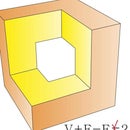Introduction: Choose Your 3D Calendar for 2021
The invention of the calendar is a remarkable event for humanity.
The fact that a year consists of 12 months is no secret to anyone. Since then, people have grouped 12 months into calendars in a variety of ways. You may have come across a polyhedron calendar before. In the overwhelming majority of cases, the dodecahedron is used as the basic geometric figure. A geometric solid consisting of 12 regular pentagons. The reason is simple - the dodecahedron has 12 faces, which means that one month can be applied to each face.
Are there other polyhedra that can do this? If we want each month to be on a separate face, then we need a geometric solid with 12 faces. We can offer the reader another polyhedron. It is a Rhombic dodecahedron. He undeservedly receives much less attention than the dodecahedron.
The Rhombic dodecahedron has 12 faces, just like the dodecahedron. The shape of the Rhombic dodecahedron faces are rhombuses and they are all equal to each other. The geometric solid has a very attractive, symmetrical shape.
Step 1: What Are the Requirements for a Rhombus Shape?
A rhombus, unlike a regular pentagon, does not have a canonical shape.
Therefore, not every rhombus is suitable for constructing a rhombic dodecahedron. If we allow ourselves different proportions of the diagonals, then the shape of the Rhombic dodecahedron will change.
See what geometric shapes are obtained for the following proportions of the diagonals of the rhombus:
- 1 to 1.414 (square root of two);
- 1 to 1.618 (golden ratio);
- 1 to 2;
- 1 to 3.
Step 2: Choosing a Shape
We suggest you glue the calendar for 2021 in the form of a Rhombic dodecahedron.
For work, we need a polyhedron shape net. Let's make a polyhedron from a single shape net that can be placed on an A4 sheet.
Remembering how unusual (not the template) the past 2020 was, we can assume that 2021 is also preparing surprises for us. Of course, I really want these to be pleasant surprises.
Therefore, in addition to the mathematically accurate version of the polyhedron - rhombic dodecahedron, we will make models of non-standard shape:
1. Calendar with precise mathematical shape. Rhombus diagonal ratio 1 to 1.414.
2. A model consisting of 12 rhombuses with the ratio of the diagonals of the rhombus in the proportions of the golden ratio 1 to 1.618.
3. And a model consisting of 12 rhombuses with a diagonal ratio of 1 to 1.732. This value was not chosen by chance. We set the task to use a single shape net to assemble a geometric solid. Then this requirement imposes certain restrictions on us. One such limitation is the theoretical limit on the ability to fit three rhombuses together. If we want to make a model of rhombuses with a large ratio of diagonals, then the rhombuses will "overlap" each other and it will simply not be possible to place three rhombuses on one sheet. The model will have to be made from separate parts.
Step 3: Assembling the 3D-Calendar
1. Print the shape net onto a sheet of paper A4 or cardboard. For ease of bending, lines can be drawn using a ballpoint pen and ruler.
2. Cut out the shape net along the outline.
3. Fold the flaps and edges.
4. Glue the flaps.
If you have a design paper on which it is difficult to print on the front side, you can make a separate geometric model and then carefully stick a calendar sheet on each side.
Attachments
Step 4: One Calendar for Everyone?
It turns out that the first day of the week may differ in different countries:
- Countries with Sunday as the first day of the week are marked in blue.
- Countries with Monday as the first day of the week are highlighted in yellow.
- Countries with Saturday as the first day of the week are marked in green.
We have prepared two versions of the calendar for you:
- the first day of the week is Sunday;
- the first day of the week is Monday.
We hope you enjoy one of these versions of the voluminous 2021 calendar!






